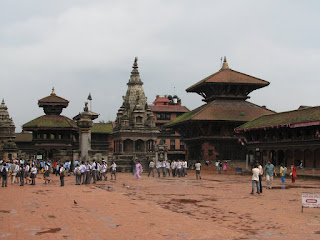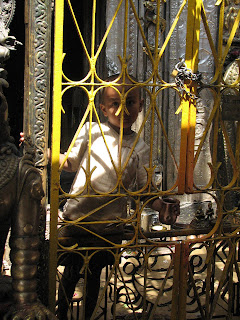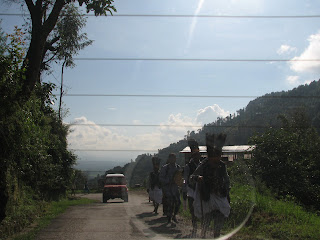Day 52-54, September 5-7, 2008 (No Malaria)
Namaste.
Of all of the places that I have visited so far, I have experienced the most culture shock (and general shock) in Nepal. It is an amazingly beautiful country that desperately wants to be in the 21st century but, in a lot of ways, is still stuck in the 19th. The country is one of the most beautiful I have seen but often lacks in the basics like sanitation or electricity. In every city that I’ve been in here, there have been rolling blackouts throughout the day. That means that specific blocks or areas do not have power for several scheduled hours each day. It is a country largely untouched by the west unlike the SE Asian counties that, through war or tourism, have had much western influence. Nepal doesn’t have a McDonalds or KFC. While this is not, by any means, the hallmark of an advance culture, they litter almost every city in SE Asia. I think that it is indicative that Nepal, landlocked between India and Tibet, has been able to resist the influences that have turned areas of most asian cities into strange imitations of any American strip mall. Nepal’s population of 27 million has retained their heritage which is unique to itself although influenced by its Indian and Tibetan neighbors.
They Nepalese people are a predominantly Hindu with Buddhism compromising most of the rest of the population From the people that I've talked to here, it seems like many people consider themselves both religions. It seems odd to claim two religions but Hindus consider Buddha an incarnation of the god Vishnu so it's not a stretch for someone to practice both. The end goal of both religions is the same which is to break the cycle of life and death in order to enter into heaven. Even the route to achieve these goals has a lot of overlap. Most temples here are primarily dedicated to one religion or the other but almost all have places to worship deities from both religions. I spent my first three days in Nepal in the Kathmandu Valley. The valley is totally surrounded by mountains and holds several cities the largest of which is the Nepali capitol of Kathmandu. Kathmandu gained some world notoriety in the 60's and 70's as a legal place to smoke marijuana drawing hippies from worldwide. The city still bears evidence of its hippy past. There is a temple called hippy temple which used to be a good place to get high and people watch and the street around the corner is called Freaky Street. As much as most Nepalese say that this is a part of their past, a marijuana culture is still present everywhere. Hindu holy men are still allowed to smoke it whenever they want and they live in caves along the river in the middle of the city. Pot still grows along the side of the road all over the country. As a matter of fact, during my jungle safari, several fun-loving Irish were also staying at the lodge. On their way to the jungle, they had their bus driver stop so they could do some “harvesting” of their own. Still to this day, each February/March, there is a huge festival in Kathmandu to honor the god Shiva. During this festival, which seems like it must be a very free spirited one, the government hands out pot to the revelers. Hundreds of thousands of people turn out for this.
They Nepalese people are a predominantly Hindu with Buddhism compromising most of the rest of the population From the people that I've talked to here, it seems like many people consider themselves both religions. It seems odd to claim two religions but Hindus consider Buddha an incarnation of the god Vishnu so it's not a stretch for someone to practice both. The end goal of both religions is the same which is to break the cycle of life and death in order to enter into heaven. Even the route to achieve these goals has a lot of overlap. Most temples here are primarily dedicated to one religion or the other but almost all have places to worship deities from both religions. I spent my first three days in Nepal in the Kathmandu Valley. The valley is totally surrounded by mountains and holds several cities the largest of which is the Nepali capitol of Kathmandu. Kathmandu gained some world notoriety in the 60's and 70's as a legal place to smoke marijuana drawing hippies from worldwide. The city still bears evidence of its hippy past. There is a temple called hippy temple which used to be a good place to get high and people watch and the street around the corner is called Freaky Street. As much as most Nepalese say that this is a part of their past, a marijuana culture is still present everywhere. Hindu holy men are still allowed to smoke it whenever they want and they live in caves along the river in the middle of the city. Pot still grows along the side of the road all over the country. As a matter of fact, during my jungle safari, several fun-loving Irish were also staying at the lodge. On their way to the jungle, they had their bus driver stop so they could do some “harvesting” of their own. Still to this day, each February/March, there is a huge festival in Kathmandu to honor the god Shiva. During this festival, which seems like it must be a very free spirited one, the government hands out pot to the revelers. Hundreds of thousands of people turn out for this.
While in Nepal, I have one driver taking me everywhere. He picked me up at the airport last Friday and will be dropping me off next Tuesday. His name is Arjun and speaks very little English. I will be in the car with Arjun, just of two of us, for somewhere around 24 hours. Those are going to be (and already have been) some long rides.
Thankfully, though, Arjun is a good driver. I don't know how people learn to drive here but traffic is, like most places, insane. In Nepal, though, there is the added obstacle on the road of livestock. Cows are considered sacred in Hinduism and there are domesticated cows living out happy existences everywhere. Some even sit in the middle of traffic fully confident that their holy butts will not end up as road kill. They also have no regard for cars and may decide to cross or change direction at any moment. Added to the cows, even in the cities, are herd of water buffalo, sheep, and goats that all use the roadside to graze and add to the chaos of traffic. Even passing busses on the road sometimes, you an see a goat or calf staring out at you from a window. That’s another reason to avoid the public busses.
The beauty of the valley and country is greatly contrasted with the filth from human occupation present everywhere. Kathmandu is an incredibly dirty city. Along almost every single roadway are piles of trash. It doesn’t look like they have any formal sanitation or the desire to organize it. Even in Cambodia, in which the roadsides are often used as trash dumps, I didn’t see anything like this. Here, there were stretches of road where trash was piled, reeking, 10 or 15 feet high. The piles were used by packs of feral dogs looking for any remaining scraps and also by herds of goats eating, well, everything they saw. As much as I love goat meat, I wouldn’t touch it in Nepal.
While in Kathmandu, I was taken to several Hindu and Buddhist temples. Most are very interesting because they are old and full of history. There are also always many colorful people hanging out at the shrines. There can be monks, con-men, or women on the prowl for a husband. At the first stupa I visited in Kathmandu (a stupa is a Buddhist shrine), I was sitting inside an adjacent monastery listening to the monks chant while my guide, Babo, waited for me outside. When I exited the monastery, he was talking to a young female security guard in Napali and they kept looking back and forth at me. When he finished, we walked away and I asked him what the conversation was about. He told me that she was from a small village, looking for a foreign husband in Kathmandu, and was wondering if I had mentioned anything about wanting to get married. Ha. She definitely picked the wrong American! So far on this trip, I could have picked up a Vietnamese kid and a Nepalese wife. I should go home now before something disastrous happens.
I also saw a local wedding.
I toured Kathmandu and the other 2 main cities of the valley named Patan and Bakhtapur. Different cities are known for different trades. Bakhtapur is known for pottery and Patan is known for metal work. Also, all three cities are very old and filled with temples. Competing rulers in the area used to get into temple building “arms races” with each other. Often associated with the temples, there are many interesting rituals and festivals. One of the more bizarre, by our standards at least, is called the Kumari festival. It is actually occurring while I am here so I’ll wait until I attend to write about it. The Nepalese also still perform animal sacrifice. One of the temples that I visited had a water buffalo’s intestines strung up above the door like a confetti streamer. It seems like the only animal that is not sacrificed fairly regularly is the venerated cow. Their way of worship is so different than anything I’m used to. In front of one temple, there was a giant mask representing a god. There were several men fighting with sticks over the right to drink alcohol from the god’s mouth. The honor to drink from the god happens only once a year so the competition is fierce. Somebody needs to take these guys to a bar! I sometimes need a drink as much as the next guy but I’m not going to get my head bashed in for it. Another temple has a little boy chosen every month as the high priest. You walk in and they have a very young, maybe 5 or 6 year old boy, locked behind bars blessing people and throwing holy water on them. It looks so out of place…an incredibly old temple and a little kid running things. 



I spent my second night in Nepal in a little town called Nagarkot. It is on the peak of a mountain at the very Northeast end of the Kathmandu Valley. The hotel was very cool and worth the hazardous drive up the mountain. The road up was barely one lane, in poor condition, winding, and full of cows, bikes, and busses. I was white knuckling it for most of the ride up. There were also some interesting local minorities walking up the mountain in their traditional dress. Nepal has over 60 minorities.
I spent my second night in Nepal in a little town called Nagarkot. It is on the peak of a mountain at the very Northeast end of the Kathmandu Valley. The hotel was very cool and worth the hazardous drive up the mountain. The road up was barely one lane, in poor condition, winding, and full of cows, bikes, and busses. I was white knuckling it for most of the ride up. There were also some interesting local minorities walking up the mountain in their traditional dress. Nepal has over 60 minorities.
My room overlooked the valley facing away from Kathmandu. It was amazing. That night, I got to see the sunset over the Himalayas. It was spectacular. In the morning, the first of many early ones I’ve had here, I watched the sunrise over the mountains from my bed.
The most interesting thing that I did while in Kathmandu was visit the public Hindu crematorium. In Napali Hindu culture, a person who dies is very quickly taken for cremation. It is usually within hours of death and it is the duty of the family to provide all of the services. This is all done along the river in the middle of the city. It is the same river where there are kids bathing, drinking, and performing other bodily necessities. The family brings the newly deceased to a platform by the river, performs some ceremonies, attends to the body, and then sets it one fire starting at the mouth. I watched the entire process. It was totally fascinating and a little revolting at times. They use a lot of grasses and fragrances while attending to the fire to mask the sights and sounds that occur during the cremation. It is possible, though, to smell and see a little too much for my western eyes and stomach. I have never seen anything like this and regardless of how fascinating it was, I hope to never again. One interesting fact is that up until about 80 years ago, if a man died in Nepal before his wife did, which was often the case, she was forced to be cremated with him alive. Imagine that being part of the wedding vows. That practice was banned before WWII but from what I have been told, it still goes on sometimes in very traditional families.
I really enjoyed my time in Kathmandu. Like most big cities on the trip, it was not my favorite place ever but is was so interesting that more than made up for the filth. I was very much looking forward to my visits to some of the more remote areas of Nepal.
4 comments:
http://www.partyatbiondis.com
SEE YOU THERE!!!!
David - BEAUTIFUL photos of the mountains & countryside. What's the altitude at your hotel? Did you get any headaches from thin air? I want to climb those mountains, my friend!!! *sigh* someday :) Keena
I cannot believe you watched a body get cremated! Any sign of Maoist insurgents?
Shu
Keena, just let me know if you ever plan your trip. I met an awesome guide that I will use when I return. Ill put you in touch with him.
Shu, no maoist insurgents. They are all in the government now.
Post a Comment